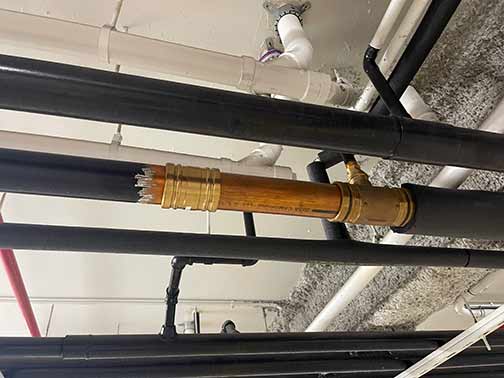
Even though you don’t see them often, there are water pipes inside the walls, floors, and ceilings of almost every room in your home. These pipes make it possible to enjoy one of the biggest wonders of modern life; access to clean water on demand.
But just as your home’s plumbing can make your life convenient, the plumbing can also cause massive destruction to your home, warns RENEW Real Estate. This happens when a plumbing pipe ruptures and spills the water inside it into the home. Burst pipes are a constant possibility with modern plumbing.
Every year, 250,000 American homes suffer property damage due to a burst pipe, and the average insurance claim for each of those homes is $15,000. What causes water pipes to burst, and how can you prevent it? More importantly, what should you do when a pipe bursts?
What to do if a pipe bursts in your home
Follow these steps to minimize water damage to your home when a burst plumbing pipe emergency occurs.
Step one: Find the main water shut-off valve and turn it off
This will turn off the water supply in your home. The main shut-off valve is usually located in the basement, near the water heater and after the water meter. Turning off the main shut-off valve will prevent further water damage to your home. If the burst pipe section has its own shut-off valve, you may also turn off the water supply at that point.
Step two: Turn off the electricity if necessary
If there is a chance that the spilled water may come into contact with a power outlet or an electrical feature in the house, you may want to disconnect the power supply to your home. This precautionary step will prevent electric shocks, short-circuiting, and damage to your home appliances.
Step three: Remove your personal belongings from the path of the water
If there are any items that the water may damage near the area of the leak, move them out of the reach of the water. This is important because if you have to make an insurance claim for damage caused by the leak, your insurer will not cover damage to those items. Removing them will reduce the cost of fixing the damage.
Step four: Take photos of the scene
You will need a visual record of what happened if you want to file an insurance claim. Take photos of the damaged pipe (or the general location of the leak if you don’t know where the burst pipe is) and the spilled water on the floor of your home. After you do the steps below (before and after you call your plumber), take photos of the scene.
Step five: Drain water from pipes
Open the faucets in your home to drain any water inside the system. Don’t do this step if you did not turn off the home’s water supply from the main shut-off valve. Only open your faucets if the water supply to the entire house is suspended. Draining the pipes will prevent accidental spillage when the damaged section of piping is either removed or repaired.
Step six: Dry up the water
Remove the water as quickly as possible by mopping it up with a mop bucket. Move items near the site of the spill to dry up any water that has collected beneath or behind them. Use a fan or dehumidifier to dry the area after mopping the water. The longer water remains on the surfaces, the more time it can penetrate and damage them; that’s why you want to be very thorough when drying your home.
Step seven: Call an emergency plumber
Do not try to fix the damaged pipe by yourself. Repairing the damaged pipe yourself could expose your home to the risk of future water damage if that damaged section of plumbing is not mended correctly. You may not get compensation from your insurer if you fix the pipe yourself and it bursts again. You are better off letting an emergency plumber handle the issue to avoid future problems.
Step eight: Learn how to prevent pipes from bursting
To save yourself the aggravation of cleaning up your home, fixing a damaged pipe, and filling out insurance paperwork after a burst pipe, here are the things you can do to prevent the problem:
- Be aware of where your main shut-off valve is. In the time you take to look for the main shut-off valve in the wrong places, water can do massive damage to your home.
- Tag the main water shut-off valve and let everyone in your household know where it is and how to use it.
- Take the right steps to protect your water pipes during winter. Many pipes burst due to frozen water inside them during winter.